May 2011
-
admiral halsey
- Posts: 83
- Joined: Mon Mar 21, 2011 8:58 am
Re: May 2011
You guys realize that I'm going to spend the whole season asking for confimation/ID of my butterflies! Here's another. I think it's a female green veined white. Captured at Langdon Hills, Willow park. Not as sharp as I would have liked, but it wouldn't sit still for more than a couple of seconds. Also seen, 1 Orange tip, 6 common blue, and 4 Speckled Wood.
Rich
Rich
There is a fine line between uninhibited and asleep
- Padfield
- Administrator

- Posts: 8192
- Joined: Sun Nov 05, 2006 10:19 pm
- Location: Leysin, Switzerland
- Contact:
Re: May 2011
Hi Rich,
That's a male green-veined white. The spots on the female are significantly bigger, especially the second, lower one. They are still more prominent in the second generation.
Guy
PS - there is an ID forum, where you can chuck as many problematic individuals as you want.
That's a male green-veined white. The spots on the female are significantly bigger, especially the second, lower one. They are still more prominent in the second generation.
Guy
PS - there is an ID forum, where you can chuck as many problematic individuals as you want.
Guy's Butterflies: https://www.guypadfield.com
The Butterflies of Villars-Gryon : https://www.guypadfield.com/villarsgryonbook.html
The Butterflies of Villars-Gryon : https://www.guypadfield.com/villarsgryonbook.html
-
admiral halsey
- Posts: 83
- Joined: Mon Mar 21, 2011 8:58 am
Re: May 2011
Thanks Guy. I'm doing my best, using four guides and the UK butterfly conservation pics, but novices like me are bound to have problems I guess. My poor point and shoot has been doing overtime these past few months. Considering the subject matter, I'm quite pleased with the results on the whole.
Rich
Rich
There is a fine line between uninhibited and asleep
- Jack Harrison
- Posts: 4635
- Joined: Wed Jan 18, 2006 8:55 pm
- Location: Nairn, Highland
- Contact:
Re: May 2011
You are in a most enjoyable time of your butterfly life when it is all so new. When you have been doing it as long as I have (around 66 years) i/d isn't the problem (except occasionally Small v Large White - shut up you lot!). I get a different buzz from butterflies today. But the "learning i/d phase" is one to savour. Enjoy.
Jack
Jack
- Lee Hurrell
- Stock Contributor

- Posts: 2423
- Joined: Mon May 25, 2009 7:33 pm
- Location: Hampshire
Re: May 2011
I have to say, my first impression was Large White. I'm still inclined towards that....Pete Eeles wrote:Yep - tricked by an illusion! Small White it is!padfield wrote:EDIT - just seen Pete's post, so third opinion needed! I think the impression of the apical patch reaching down the outer margin is an illusion caused by the fringe of the hindwing inside it.
Cheers,
- Pete
On the subject of size, I saw a definite 'Small White sized' Large White last summer so you can't always go by that either!
Cheers
Lee
To butterfly meadows, chalk downlands and leafy glades; to summers eternal.
Re: May 2011
....well, to stick my head on the chopping-board.....
I would say it is a Small White.....
based on what Guy said, and the fact that it just doesn't "feel" right for a Large White...
(and finally, there are very few reports of Large White around at the moment...
...unless that is based on everyone mixing-up all these large Small Whites.... )
)
N
(Edit: Don't get our transect walkers and recorders started on recording Whites, please...!)
..here's a teaser...
I would say it is a Small White.....
based on what Guy said, and the fact that it just doesn't "feel" right for a Large White...
(and finally, there are very few reports of Large White around at the moment...
...unless that is based on everyone mixing-up all these large Small Whites....
N
(Edit: Don't get our transect walkers and recorders started on recording Whites, please...!)
..here's a teaser...
"Conservation starts in small places, close to home..."
Re: May 2011
Walked from Borth y Gest (near Portmadog) to Criccieth in North Wales today. Was very happy to see a thriving colony of Small Pearl Bordered Fritillary's surviving just inland from the coast, along the railway just to the east of Criccieth. Must have been around 20 mostly freshly emerged. Also saw a few stragglers close to Borth y Gest.
Interesting to see them in this location, close to the sea and without many trees. I always thought of them as a woodland glade based butterfly.
Interesting to see them in this location, close to the sea and without many trees. I always thought of them as a woodland glade based butterfly.
Re: May 2011
Regards confusion with the whites, just do what the birders do with "tricky pairs". Hence if it could be a Common or Arctic Tern - "Comic Tern"! Carrion Crow or Rook - "Crook"! Marsh or Reed Warbler..."oh bugger, this could be awkward...ooh look over there - a butterfly!" (cue a rapid evac away from the demonic bird and pretend you never saw it) 
Raising £10,000 for Butterfly Conservation by WALKING 1200 miles from Land's End to John O'Groats!!!
See http://www.justgiving.com/epicbutterflywalk or look up Epic Butterfly Walk on Facebook.
See http://www.justgiving.com/epicbutterflywalk or look up Epic Butterfly Walk on Facebook.
Re: May 2011
I can't tell a small white from a green-veined.  However I am a master of identifying large whites
However I am a master of identifying large whites 

Today on the Welsh Coast near Barmouth after days of cloudy and windy weather the sun came out and my first Wall of the year.
Today on the Welsh Coast near Barmouth after days of cloudy and windy weather the sun came out and my first Wall of the year.
Re: May 2011
"..one I took earlier". But who am I?
OK - not easy....
Perhaps this may help... Went out to look for butterflies - found only a few
3 CB males, 1 GH, 1 Large White (honestly), 1 Small White, 2 OTs, my first Large Skipper of the year (but only one), 1 HB and about 4 Brown Argus - including Mr & Mrs...
"Conservation starts in small places, close to home..."
Re: May 2011
I booked today off from work due to the sunny forecast (although maximum temperatures never got better than 17C) and headed to Sand Point*, like so many others, to see if I could see any Glanville Fritillaries.
I arrived really early to miss the traffic (about 8.30am) and found it to be a particularly beautiful spot irrespective of any butterflies (except for the parrots screeching near the entrance which you could still hear at the top of the steps!!)
I followed the advice of Zonda and Jack Harrison, but sadly it seems they have run their course for this year, as I didn't see a single one in spite of doing a thorough search which sometimes took me precariously near the edge of the sheer cliff face. I remained on the site till after midday but had to give up as I had a second destination to visit.
The fort was very interesting and the views over the Severn Estuary were superb. Plenty of Wall Browns were about (which was nice), and I saw my first Brown Arguses of the year to boot. Totals were:
1. Common Blue 40-60
2. Small Heath 30-50
3. Wall Brown 20-30
4. Brown Argus 10
5. Small White 3
6. Small Copper 2
7. Peacock 1
*Footnote - Unbeknown to me at the time, I was actually on Brean Down, which is the headland 5 miles south of Sand Point. Silly boy!
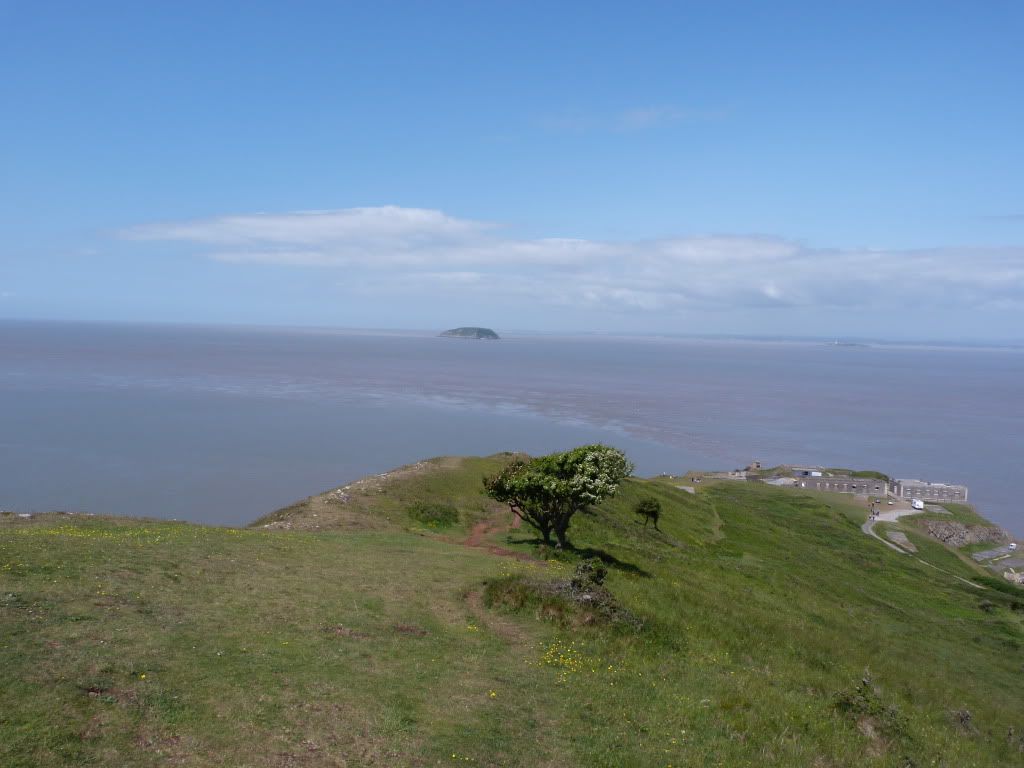
Nice, clear views over the estuary to Wales
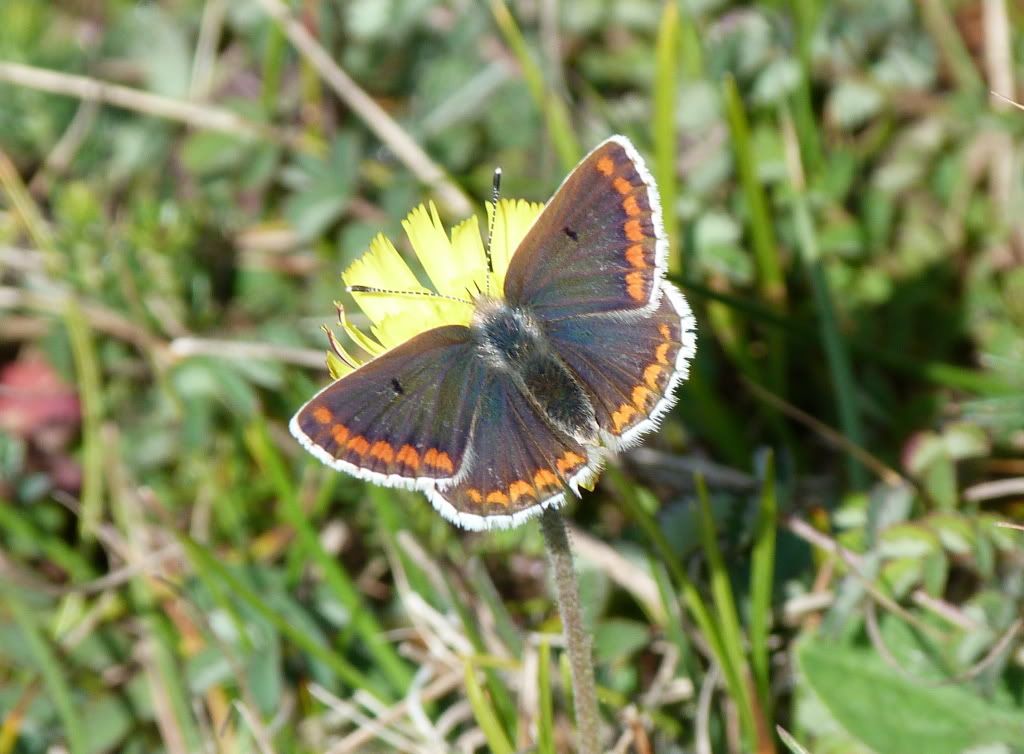
Female Brown Argus
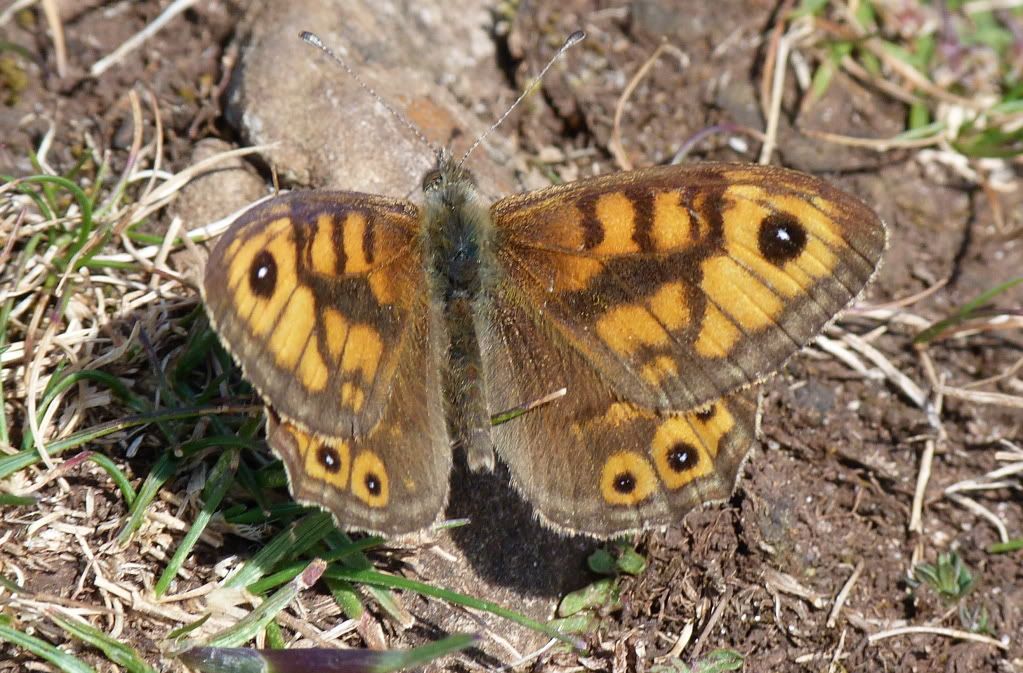
One of the few Wall Browns that settled for more than 5 seconds!
I arrived really early to miss the traffic (about 8.30am) and found it to be a particularly beautiful spot irrespective of any butterflies (except for the parrots screeching near the entrance which you could still hear at the top of the steps!!)
I followed the advice of Zonda and Jack Harrison, but sadly it seems they have run their course for this year, as I didn't see a single one in spite of doing a thorough search which sometimes took me precariously near the edge of the sheer cliff face. I remained on the site till after midday but had to give up as I had a second destination to visit.
The fort was very interesting and the views over the Severn Estuary were superb. Plenty of Wall Browns were about (which was nice), and I saw my first Brown Arguses of the year to boot. Totals were:
1. Common Blue 40-60
2. Small Heath 30-50
3. Wall Brown 20-30
4. Brown Argus 10
5. Small White 3
6. Small Copper 2
7. Peacock 1
*Footnote - Unbeknown to me at the time, I was actually on Brean Down, which is the headland 5 miles south of Sand Point. Silly boy!

Nice, clear views over the estuary to Wales

Female Brown Argus

One of the few Wall Browns that settled for more than 5 seconds!
Last edited by David M on Fri May 20, 2011 11:11 am, edited 1 time in total.
Re: May 2011
After leaving Sand Point, I headed for Bin Combe, a valley on Exmoor not far from Minehead. I arrived at 1420hrs and spent 3 hours there (although due to the terrain over an hour of that was taken up by walking down to the site and then struggling back up).
This is not a location for the faint hearted - on the National Trust website it is described as "extreme butterflying", and that is a description that I would support, given the difficulty of the terrain and the complete lack of any human-friendly pathways.
At the beginning of the day I had thought it highly likely that I would see Glanville Fritillaries at Sand Point but that Heath Fritillaries in this locality would be a long shot. That was the case for a good 3/4 of an hour, until I descended the steep bank (slipping once and putting my hand in gorse to try and break my fall). I suddenly noticed a Wall Brown-like butterfly several metres below me. I knew that this wasn't Wall territory so I made my way further down almost to the bottom of the Combe, whereupon I saw not one, but several Heath Fritillaries flying amongst the bracken. They were constantly active, and at this point I became aware of a handful of Green Hairstreaks that were in flight in the same area.
The hillside was extremely steep, and any attempt to ascend was a 'hold onto a firm piece of vegetation' job. I noticed a few more Heaths above me now, and to the right there was a fairly level piece of land, so I climbed onto it and as the sun went behind a cloud, a Heath Fritillary decided to remain in situ for me to get close to.
After spending about 40 minutes around this area I decided that since I was at the bottom of the hill I would make my way back at the lowest level aside the stream. This paid dividends, as about 200m further along there were a few more individuals until their presence abruptly halted as soon as the terrain forced me to go sharply upwards back towards the upper heathland.
So, two distinct colonies were seen, each covering no more than 100m in length and separated by about 200m of terrain from which they were absent. The first colony lower down contained 15-20 individuals whilst the second had about half a dozen.
It never ceases to amaze me just how specialised certain butterflies can be. These Heath Fritillaries are obviously clinging on to a tiny fragment of the environment, yet even within that environment they congregate in a ridiculously small area; yet where they DO congregate they can be seen in numbers.
Details of the site can be seen here: http://www.nationaltrust.org.uk/main/w- ... _combe.pdf
It's a tough undertaking, but this species clearly thrives in pockets of this site and at the moment they all appear to be fresh and barely blemished.
The full tally of butterflies seen was:
1. Small Heath 80-120
2. Heath Fritillary 20-25
3. Green Veined White 15-25
4. Green Hairstreak 5
5. Small Copper 2
6. Orange Tip (probably my last of the year) 1
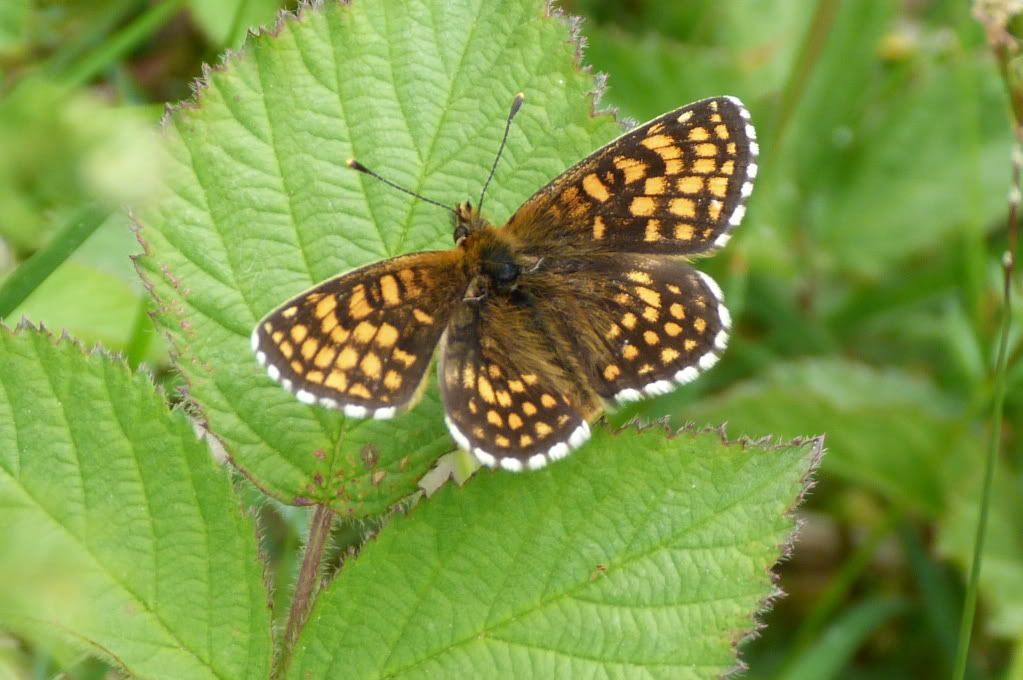
I thought I'd never get a photo till the sun suddenly went behind a cloud and this one remained still for a good 3 or 4 minutes

This one seemed to have a deformed antenna
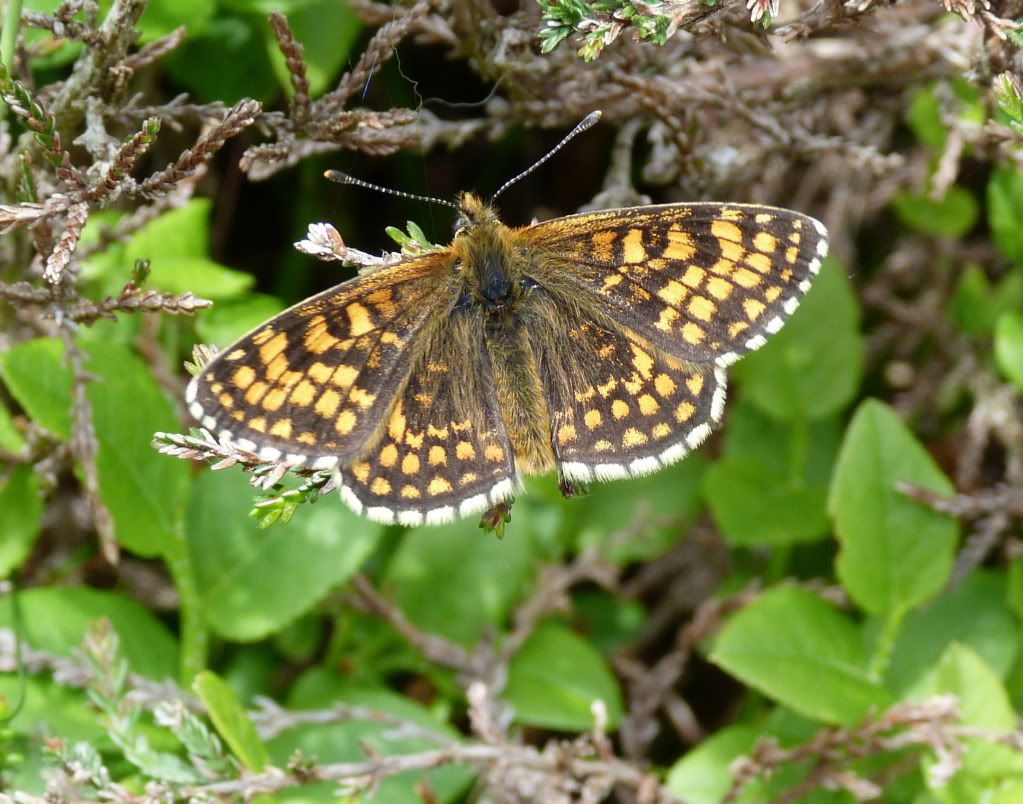
This one was in the smaller colony which, thankfully, was found on fairly level terrain
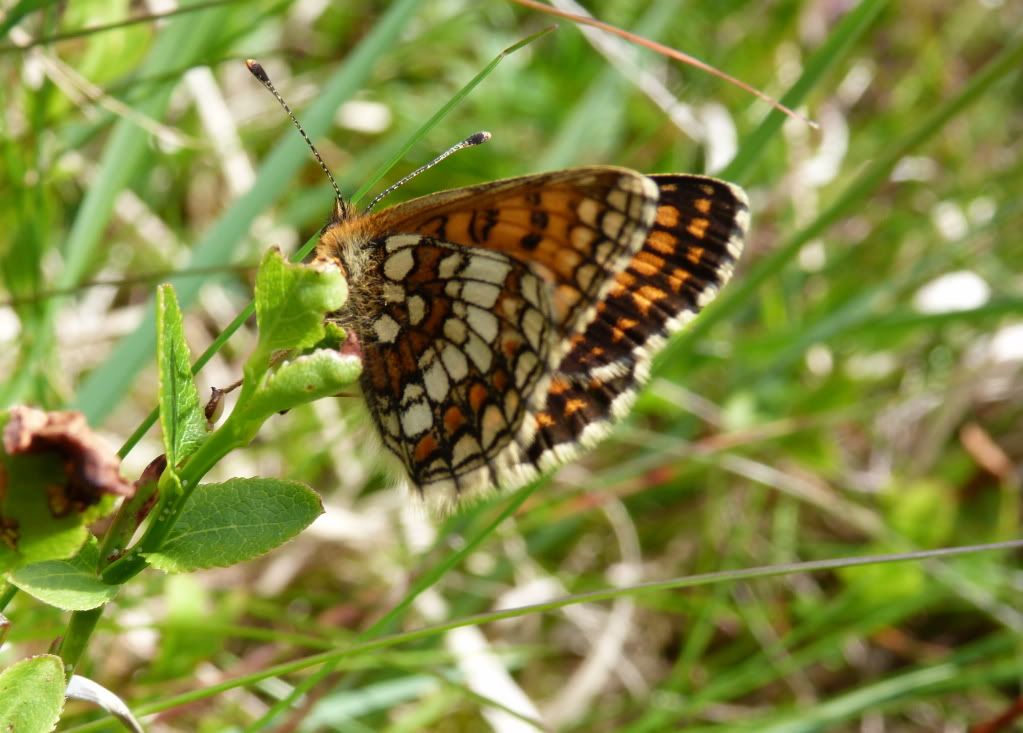
The undersides, as ever, are the defining feature.
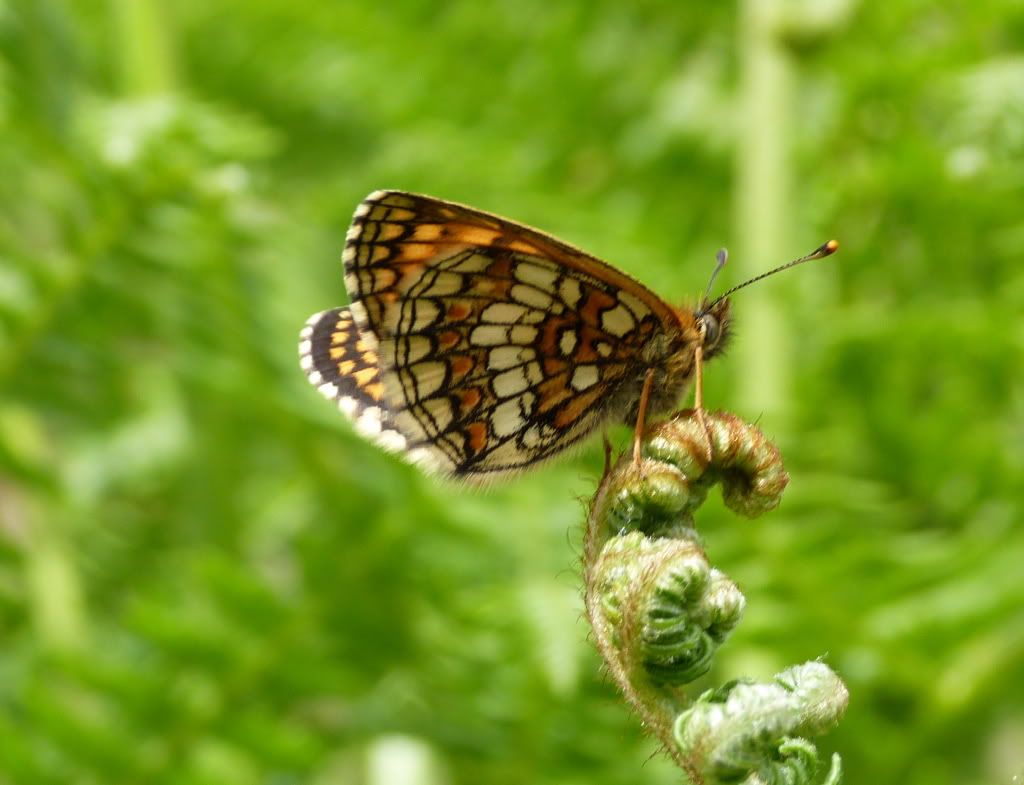
This one was most obliging
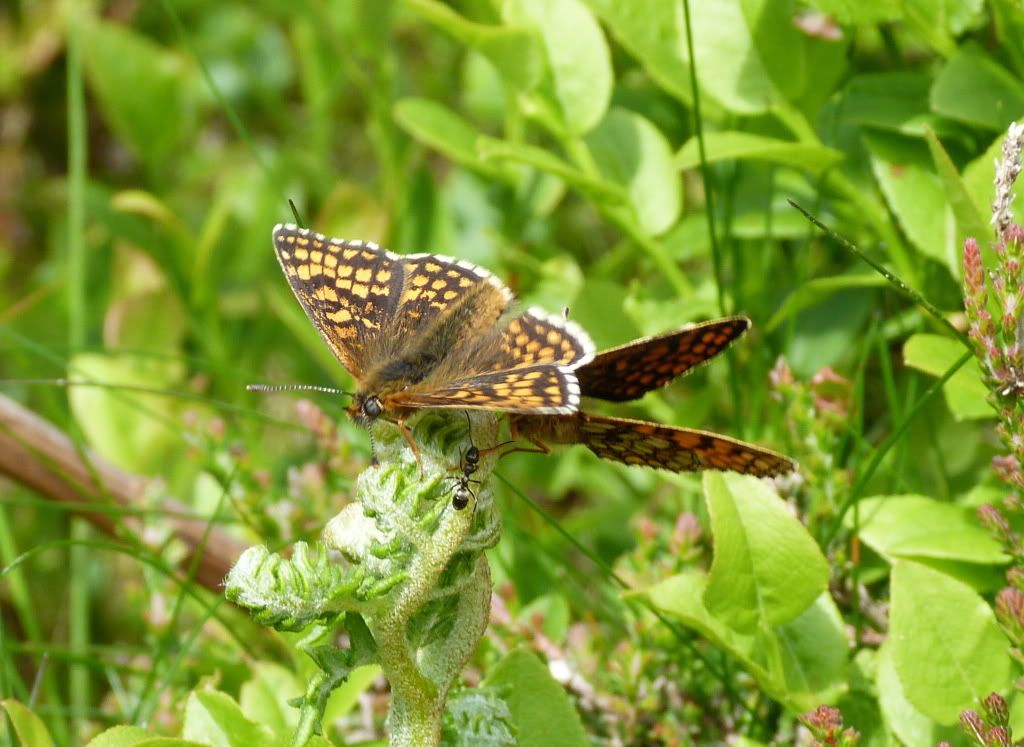
It was only after uploading this onto my PC that I noticed these two Heaths had a gatecrasher!
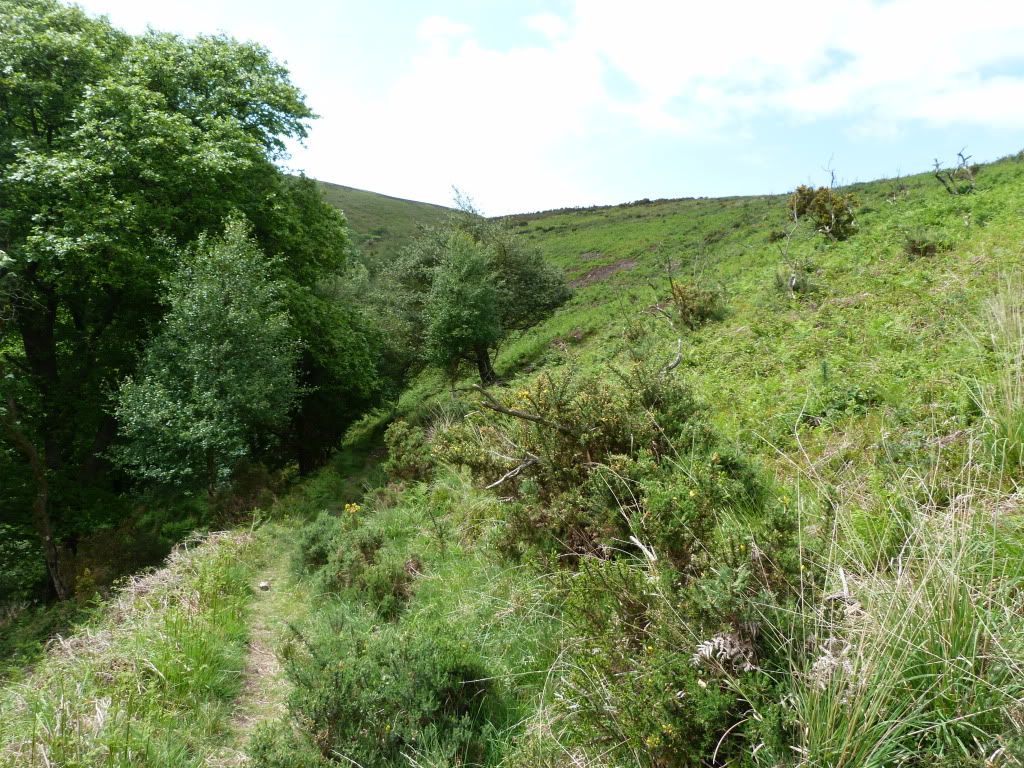
This was the main hotspot, though it was hard to reach and difficult to negotiate your way out of.
This is not a location for the faint hearted - on the National Trust website it is described as "extreme butterflying", and that is a description that I would support, given the difficulty of the terrain and the complete lack of any human-friendly pathways.
At the beginning of the day I had thought it highly likely that I would see Glanville Fritillaries at Sand Point but that Heath Fritillaries in this locality would be a long shot. That was the case for a good 3/4 of an hour, until I descended the steep bank (slipping once and putting my hand in gorse to try and break my fall). I suddenly noticed a Wall Brown-like butterfly several metres below me. I knew that this wasn't Wall territory so I made my way further down almost to the bottom of the Combe, whereupon I saw not one, but several Heath Fritillaries flying amongst the bracken. They were constantly active, and at this point I became aware of a handful of Green Hairstreaks that were in flight in the same area.
The hillside was extremely steep, and any attempt to ascend was a 'hold onto a firm piece of vegetation' job. I noticed a few more Heaths above me now, and to the right there was a fairly level piece of land, so I climbed onto it and as the sun went behind a cloud, a Heath Fritillary decided to remain in situ for me to get close to.
After spending about 40 minutes around this area I decided that since I was at the bottom of the hill I would make my way back at the lowest level aside the stream. This paid dividends, as about 200m further along there were a few more individuals until their presence abruptly halted as soon as the terrain forced me to go sharply upwards back towards the upper heathland.
So, two distinct colonies were seen, each covering no more than 100m in length and separated by about 200m of terrain from which they were absent. The first colony lower down contained 15-20 individuals whilst the second had about half a dozen.
It never ceases to amaze me just how specialised certain butterflies can be. These Heath Fritillaries are obviously clinging on to a tiny fragment of the environment, yet even within that environment they congregate in a ridiculously small area; yet where they DO congregate they can be seen in numbers.
Details of the site can be seen here: http://www.nationaltrust.org.uk/main/w- ... _combe.pdf
It's a tough undertaking, but this species clearly thrives in pockets of this site and at the moment they all appear to be fresh and barely blemished.
The full tally of butterflies seen was:
1. Small Heath 80-120
2. Heath Fritillary 20-25
3. Green Veined White 15-25
4. Green Hairstreak 5
5. Small Copper 2
6. Orange Tip (probably my last of the year) 1

I thought I'd never get a photo till the sun suddenly went behind a cloud and this one remained still for a good 3 or 4 minutes

This one seemed to have a deformed antenna

This one was in the smaller colony which, thankfully, was found on fairly level terrain

The undersides, as ever, are the defining feature.

This one was most obliging

It was only after uploading this onto my PC that I noticed these two Heaths had a gatecrasher!

This was the main hotspot, though it was hard to reach and difficult to negotiate your way out of.
Re: May 2011
I dropped in on Odd Down on the way home, to see if the Small Blue population is out and about yet. It seems not, which is perhaps just as well as the foodplant is still a long way from being in flower. This seems to be a 'late' site, as the same was the case last year when the butterfly was already on the wing elsewhere in the county.
- Rogerdodge
- Posts: 1177
- Joined: Tue Jan 31, 2006 6:06 pm
- Location: North Devon
Re: May 2011
David M
I think the main reason you didn't see Glanvilles at Sand Point is because you were on Brean Down!
There is no fort at Sand Point!
Sand Point is 5 miles north of Brean.
I am off to Bin Combe tomorrow - the photo is a spot I recognise. I have had best success at the area of exposed rock that is just visible in your picture, a few hundred yards ahead of you.
Thanks for the information - it means that, as I scramble up and down the combe, I know it won't be in vain.
Cheers
I think the main reason you didn't see Glanvilles at Sand Point is because you were on Brean Down!
There is no fort at Sand Point!
Sand Point is 5 miles north of Brean.
I am off to Bin Combe tomorrow - the photo is a spot I recognise. I have had best success at the area of exposed rock that is just visible in your picture, a few hundred yards ahead of you.
Thanks for the information - it means that, as I scramble up and down the combe, I know it won't be in vain.
Cheers
Last edited by Rogerdodge on Fri May 20, 2011 5:03 pm, edited 1 time in total.
Cheers
Roger
Roger
Re: May 2011
I think you mean David M...Rogerdodge wrote:Matsukaze I think the main reason you didn't see Glanvilles at Sand Point is because you were on Brean Down!
Cheers
A nice couple of reports David. As much as the butterfly shots are nice, I especially enjoyed the first landscape photograph (Brean Down?).
Michael
Re: May 2011
Bugger!Rogerdodge wrote: I think the main reason you didn't see Glanvilles at Sand Point is because you were on Brean Down!
There is no fort at Sand Point!
Sand Point is 5 miles north of Brean.
I am off to Bin Combe tomorrow - the photo is a spot I recognise. I have had best success at the area of exposed rock that is just visible in your picture, a few hundred yards ahead of you.
Thanks for the information - it means that, as I scramble up and down the combe, I know it won't be in vain.
Cheers
No wonder I didn't find any. You're right, I was on the wrong bit of headland, though there IS a stile as well as a concrete Trig point at the top of the hill (as described in Jack's commentary a couple of weeks ago) at Brean Down as well.
Oddly enough, he also mentioned a seat which was conspicuous by its absence. I should have questioned things at that point.
Still, the lesson is 'do your research properly'.
Thankfully, I did just that regarding Bin Combe, and I wish you luck if you're going there to see them yourself. You'll definitely find some, but as I mentioned you'd better be prepared for aching legs and much slipping and sliding.
- Jack Harrison
- Posts: 4635
- Joined: Wed Jan 18, 2006 8:55 pm
- Location: Nairn, Highland
- Contact:
Re: May 2011
Gibster:
Jack
Have you been to the Farne Islands Seth? It is an absolute "must" even for non-birders. But do NOT forget a hat. Those little blighters have very sharp beaks and they hurt even through a floppy hat. The wardens wear something much more substantial....Common or Arctic Tern...
Jack
- Rogerdodge
- Posts: 1177
- Joined: Tue Jan 31, 2006 6:06 pm
- Location: North Devon
Re: May 2011
My plan to visit Heddon Valley today for the very early High Brown Frit got a bit mucked about by the weather.
I had to wait for four hours in mist and drizzle at my Heath Frit site for one to appear in a brief period of sunshine.
Then off to the only Marsh Frit site on Exmoor.
En-route, I got attacked by an Exmoor Pony stallion.
It seems I had wandered too close to a new born foal hiding in the heather.
The stallion galloped up to me, brayed and, teeth bared, it reared up on it's hind legs and slashed at me with it's front hooves just missing my head!
Bloody terryfying.
That was a first (and I hope, a last) for me after thousands of hours on Exmoor!!!
Anyway, just 50 yards from the scene of the battle, I encountered at least two skulking Marsh Frits. The wind was over 30 mph, and the cloud cover 70%, so not a lot of hope for a good photograph.
Nevertheless, it was great to see this species in such a rare location.
Planning on Heddon Valley (and the Hunter's Inn for lunch - yum!) tomorrow.
I had to wait for four hours in mist and drizzle at my Heath Frit site for one to appear in a brief period of sunshine.
Then off to the only Marsh Frit site on Exmoor.
En-route, I got attacked by an Exmoor Pony stallion.
It seems I had wandered too close to a new born foal hiding in the heather.
The stallion galloped up to me, brayed and, teeth bared, it reared up on it's hind legs and slashed at me with it's front hooves just missing my head!
Bloody terryfying.
That was a first (and I hope, a last) for me after thousands of hours on Exmoor!!!
Anyway, just 50 yards from the scene of the battle, I encountered at least two skulking Marsh Frits. The wind was over 30 mph, and the cloud cover 70%, so not a lot of hope for a good photograph.
Nevertheless, it was great to see this species in such a rare location.
Planning on Heddon Valley (and the Hunter's Inn for lunch - yum!) tomorrow.
Cheers
Roger
Roger
- Jack Harrison
- Posts: 4635
- Joined: Wed Jan 18, 2006 8:55 pm
- Location: Nairn, Highland
- Contact:
Re: May 2011
Roger:
Jack
I suppose if you had turned your back on the stallion and cowered in self-defence it might have attempted something even more unpleasantThe stallion galloped up to me, brayed and, teeth bared, it reared up on it's hind legs and slashed at me with it's front hooves just missing my head!
Bloody terryfying.
Jack
Re: May 2011
Hiya Jack,Jack Harrison wrote:Have you been to the Farne Islands Seth? It is an absolute "must" even for non-birders. But do NOT forget a hat. Those little blighters have very sharp beaks and they hurt even through a floppy hat.
I have a nice little scar across my nose from a Great Skua which dive bombed me as I was crouched down checking an egg shell. I kinda sensed something coming my way at speed and looked over my shoulder at precisely the wrong moment! Trust me, Arctic Terns are pussycats compared to an incoming Bonxie!!
PS Haven't been to The Farnes yet, but I've been to Handa several times. Less terns maybe, but a whole lot less people too
PPS Visitors to Handa are 'briefed' about divebombing skuas. They go for the highest point, so it was suggested that a scope/camera tripod was raised above head height, or maybe an umbrella. We all duly nodded, then set off. One chap imediately hoisted his young child onto his shoulders and boldly strode off into Skuasville...poor kid must be severely phobic by now lol!!!
Raising £10,000 for Butterfly Conservation by WALKING 1200 miles from Land's End to John O'Groats!!!
See http://www.justgiving.com/epicbutterflywalk or look up Epic Butterfly Walk on Facebook.
See http://www.justgiving.com/epicbutterflywalk or look up Epic Butterfly Walk on Facebook.
